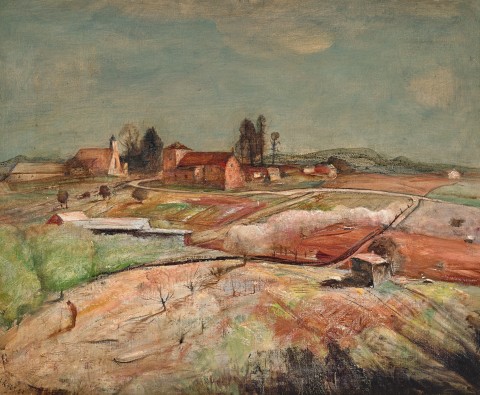RYDE LANDSCAPE, 1952
LLOYD REES
oil on canvas
45.5 x 56.0 cm
signed and dated lower left: L REES 52
Macquarie Galleries, Sydney
Dr and Mrs Norman Wettenhall, Melbourne (bears inscription verso)
Christie’s, Sydney, 3 – 4 October 1972, lot 110
Joseph Brown Gallery, Melbourne
Mr Alan Greenway, Australia and USA, acquired from the above
Thence by descent
Private collection, California, USA
Christmas Exhibition, Macquarie Galleries, Sydney, 10 – 23 December 1952, cat. 23 (label attached verso)
Lloyd Rees Retrospective, Art Gallery of New South Wales, Sydney, 2 October – 2 November 1969, touring State galleries and Newcastle City Art Gallery to August 1970, cat. 48 (label attached verso)
Free, R., Lloyd Rees Retrospective, Art Gallery of New South Wales, Sydney, 1969, p. 28
Free, R., Lloyd Rees, Lansdowne Australian Art Library, Melbourne, 1972, cat. O151 (illus.)
During the years between 1947 and 1953, Lloyd Rees spent his Saturday afternoons painting with a group of fellow artists who all lived nearby. Informally known as the Northwood (aka Norwood) Group after the name of Rees’ home suburb on Sydney’s lower north shore, their number included Roland Wakelin, George Lawrence, John Santry and Marie Santry; and one of their regular destinations was North Ryde, a (then) small village some ten kilometres away, described by Rees as ‘a charming little collection of buildings set among orchards to the east and south and the rolling golf-links to the west, a church, two stores, an old hall, a school and a scattering of homes… our own little Barbizon.’1
Rapid sketches were done on the spot, built upon later in the group’s various home studios, and other examples by Rees include Evening at Nth Ryde, 1948, and Dusk at Nth Ryde, 1948 (both Art Gallery of New South Wales); and The Italian’s Cottage, North Ryde, 1952 (private collection, c/- Queensland Club). Apart from the production of a wonderfully evocative series of paintings, of which Ryde Landscape, 1952, is a fine example, Rees also benefitted greatly from ‘the great boon of companionship and the endless discussions so dear to the artist.’2 It is important to note that these were not topographically accurate views by Rees as he was more concerned with applying intellect and emotion to craft a scene which appealed on many levels. In an interview, he stated that an artist needed to be a ‘commander’ able to ‘control and mould and express (one’s) own will’ when handling paint and the depiction of a subject.3
One of Rees’ great heroes was Jean-Baptiste-Camille Corot, the first French artist to paint en plein air in the forests of Barbizon, but he also absorbed ideas by artists as diverse as Cézanne, Van Gogh, Arthur Streeton and Arthur Boyd. In 1947, Rees painted one of his masterpieces, the highly influential Road to Berry (Art Gallery of New South Wales) which features a set of gently rolling hills bisected by interconnecting roads. The influence of Corot echoes throughout this painting particularly with its low, even crepuscular, light, and in the sinuous lines of the roads which recall the curved trunk of a tree that Corot painted many times – one example being The bent tree (L'Arbre penché), 1855 – 1860 (National Gallery of Victoria). In a similar manner in Ryde landscape, what is now Victoria Road twists between the church (a simplified vision of St Charles Berremo, built 1857) and the large building opposite before setting a strong horizontal line that is then bisected diagonally by a short road leading to a line of fencing. What appears to be a plume of dust emphasises this area further whilst the subdued palette of soft greens and russet hark back to Rees’s own depictions of the Bathurst region from previous years. Adding interest and a touch of mystery is the artist’s delicate treatment of the hills beyond, executed in a wash of darkened blue-grey. It is a peaceful view but a forceful one, in line with the Rees’s strongly held belief that ‘once a picture has come to life, it dictates the terms of its own creation.’4
1. Rees, L., The small treasures of a lifetime: some early memories of Australian art and artists, Collins, Sydney, 1969/1984, p. 145
2. ibid., pp. 146 – 47
3. Lloyd Rees, interview with Hazel de Berg, c.1962, cited at https://www.portrait.gov.au/words/lloyd-rees Viewed 29.03.2022
4. Lloyd Rees, quoted in Free, R., Lloyd Rees, Lansdowne, Melbourne, 1972, p. 101
ANDREW GAYNOR
